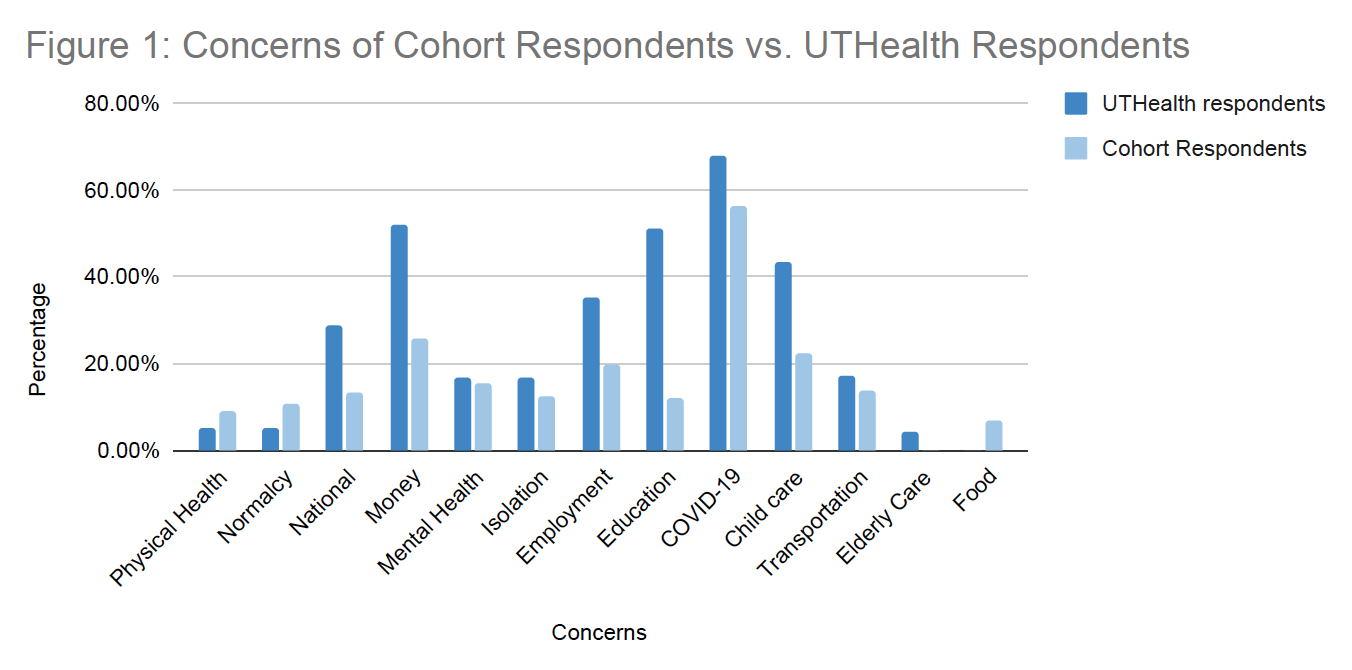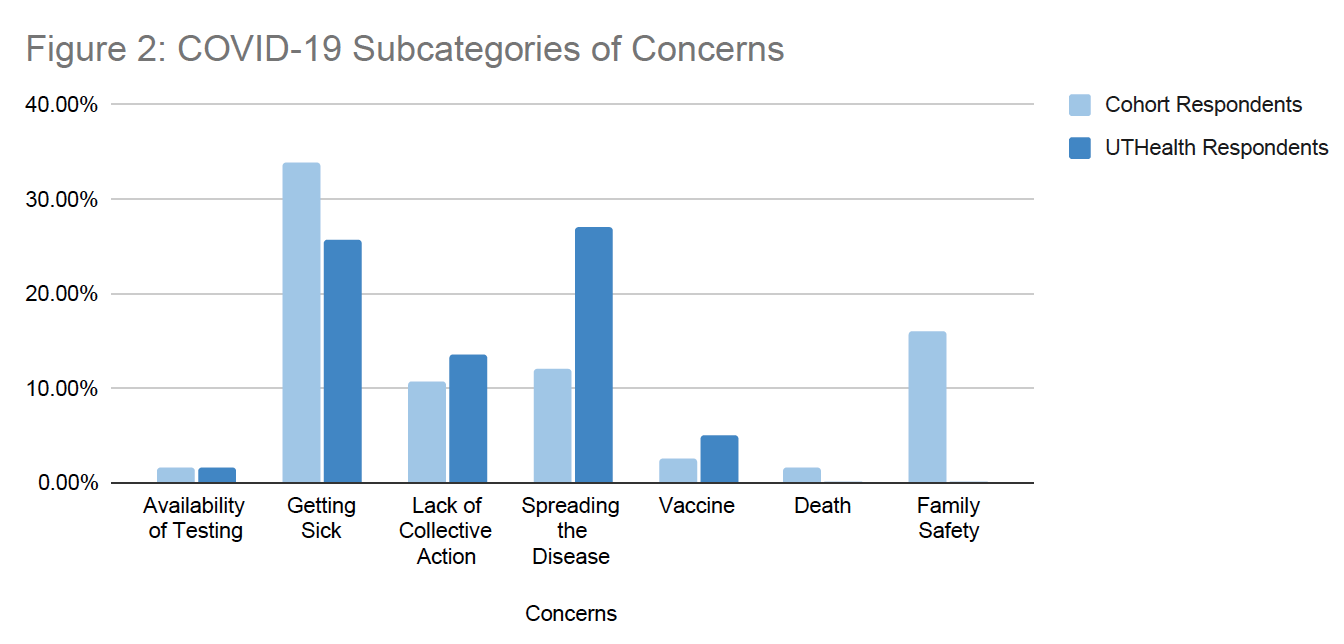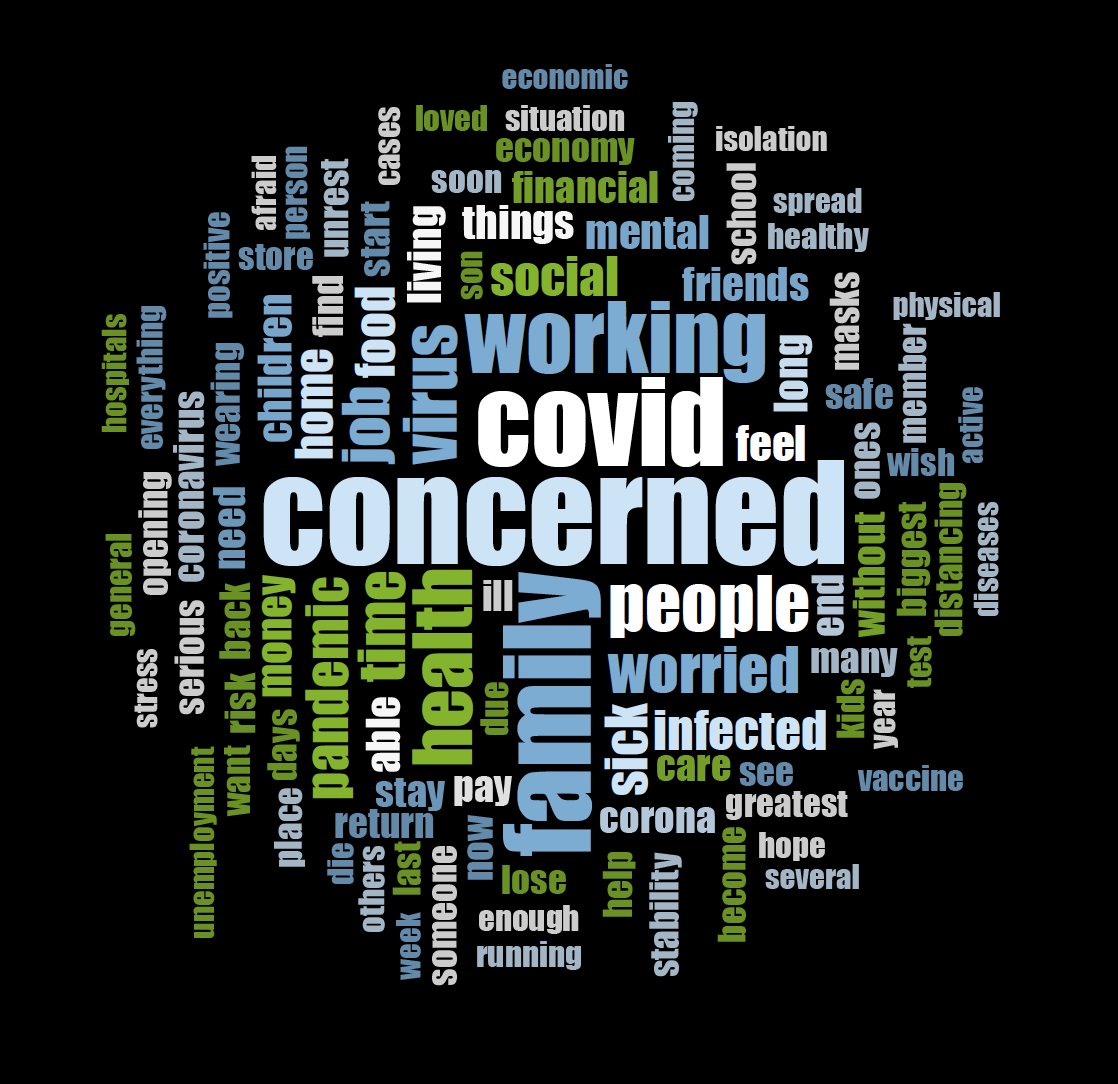Snapshot of Concerns among Texas Residents during the COVID-19 Pandemic
Published: October 26, 2020
The coronavirus outbreak has forced many Americans to work from home or shelter-in-place for the last nine months. The mandatory stay-at-home order issued by most U.S. states has affected Americans in different ways. Naturally, some were relieved to be working from the comfort of their homes, spending extra time with family members, and learning new skills. Many others were, and are, struggling daily, worrying about how they will find a new job in the midst of a pandemic and how they will keep food on the table. There are also healthcare workers who go to work every day to save lives and come home to concerned family members. Even if these individuals take all necessary precautions to protect themselves and their family members, COVID-19 exposure is always a possibility. Many Americans fall between these groups, coping with the pandemic and stay-at-home orders in their own specific way.
 In order to determine specific concerns of individuals in different socio-economic groups, researchers at the University of Texas Health Science Center (UTHealth) School of Public Health in Austin conducted a survey with two different groups of individuals. One group was recruited from an on-going UTHealth cohort study with Travis County residents living in low-income communities (n=366), representing a lower–income population. The second group was recruited from the UTHealth School of Public Health in Austin and included faculty and staff (n=106), representing a higher income population. A 57-question survey was sent to all participants via text or email in June. The survey’s final question asked participants to “Please share your greatest concern at this time, or any other thoughts you would like to let us know.” This allowed participants to express themselves outside of the structured, multiple choice questions that made up the majority of the survey. 282 (77%) of the cohort participants and 79 (75%) of UTHealth faculty and staff responded to the final question.
In order to determine specific concerns of individuals in different socio-economic groups, researchers at the University of Texas Health Science Center (UTHealth) School of Public Health in Austin conducted a survey with two different groups of individuals. One group was recruited from an on-going UTHealth cohort study with Travis County residents living in low-income communities (n=366), representing a lower–income population. The second group was recruited from the UTHealth School of Public Health in Austin and included faculty and staff (n=106), representing a higher income population. A 57-question survey was sent to all participants via text or email in June. The survey’s final question asked participants to “Please share your greatest concern at this time, or any other thoughts you would like to let us know.” This allowed participants to express themselves outside of the structured, multiple choice questions that made up the majority of the survey. 282 (77%) of the cohort participants and 79 (75%) of UTHealth faculty and staff responded to the final question.
In an effort to compare and better understand the concerns of both groups, the results were organized together. Figure 1 displays the UTHealth respondents’ concerns, alongside the cohort’s concerns. The top five concerns of the lower SES group were:
- Becoming infected with COVID-19 (56.48%)
- Lack of money (25.69%)
- Childcare (22.50%)
- Employment (19.88%)
- Mental Health (15.32%)
The top five concerns of the higher SES group were:
- Becoming infected with COVID-19 (68.02%),
- Lack of money (51.82%)
- Education (50.99%).
- Childcare (43.48%)
- Employment (35.07%)
More specifically, the primary concerns falling under the category of education were:
- whether or not children would be returning to school in the fall
- The dangers and risks of sending kids back to school during a pandemic
- The struggle of homeschooling
 To take the concern analysis a step further, the COVID-19 survey responses were subcategorized. By doing this, it was easier to understand what respondents were specifically concerned about regarding COVID-19. Figure 2 shows that cohort respondents were primarily concerned with getting sick (33.90%), followed by family safety (16.12%), and spreading of the disease (11.99%). The UTHealth respondents were primarily concerned with the spread of COVID-19 (27.12%), followed by getting sick (25.65%), and lack of collective action (13.56%). Individuals concerned with lack of collective action were worried that members of their community were not adhering to the recommended CDC protocols of mask-wearing and social-distancing.
To take the concern analysis a step further, the COVID-19 survey responses were subcategorized. By doing this, it was easier to understand what respondents were specifically concerned about regarding COVID-19. Figure 2 shows that cohort respondents were primarily concerned with getting sick (33.90%), followed by family safety (16.12%), and spreading of the disease (11.99%). The UTHealth respondents were primarily concerned with the spread of COVID-19 (27.12%), followed by getting sick (25.65%), and lack of collective action (13.56%). Individuals concerned with lack of collective action were worried that members of their community were not adhering to the recommended CDC protocols of mask-wearing and social-distancing.
It should be noted that overall, regardless of SES, there were few differences in concerns between the two groups. This is also seen in Figure 3 which depicts word frequency and shows the importance both groups assigned to specific concerns. What made this study unique is that it allowed participants to express themselves and their concerns honestly with a fill-in question, opening the door to a different issue: how people are feeling during COVID-19. Understandably, COVID-19 was the greatest concern for both groups, primarily getting the illness and spreading it to others. This primary fear may have motivated Americans to stay at home during the first few months of the pandemic, which in turn could have played a role in successfully lowering the number of COVID-19 cases in Texas during the months of April and May.
 After months of limiting outings and working from home, people are becoming more uncomfortable staying at home. Many Texans have started venturing outside of their homes, some adhering to mask regulations and adapting to the new “normal” of social distancing. Some schools are even open and teaching in-person. The question is: have Texas residents’ COVID-19 concerns disappeared or are they ignoring their worries because they are desperate to get back to normal life? The results of this study are a reminder that as this pandemic ensues, we are all going through similar experiences of frustration and hardship. It is a reminder that we are not alone during these difficult times.
After months of limiting outings and working from home, people are becoming more uncomfortable staying at home. Many Texans have started venturing outside of their homes, some adhering to mask regulations and adapting to the new “normal” of social distancing. Some schools are even open and teaching in-person. The question is: have Texas residents’ COVID-19 concerns disappeared or are they ignoring their worries because they are desperate to get back to normal life? The results of this study are a reminder that as this pandemic ensues, we are all going through similar experiences of frustration and hardship. It is a reminder that we are not alone during these difficult times.
Written by: Reem Salhab and Veronica Herrera, MPH Students at the UTHealth School of Public Health in Austin



Discussion